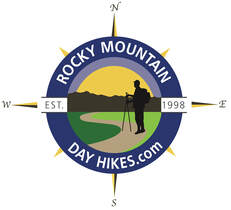|
Notes from the
Trail |
|
Arduous was the word that got my attention. Such an interesting word choice the National Park Service chose to describe a temporary diversion trail around a naturally occuring, slow moving landslide that crossed the trail to Timber Lake. And yet, after having climbed the flag marked trail that takes the hiker up one side of the landslide, and then down the other side back to the trail, that was without a doubt the perfect word to use; it was difficult and tiring.
Once past the detour, the trail begins to paralell Timber Creek. After stopping along the way to photograph a patch of Heartleaf Arnica, I travel easily along this part of the trail as it stays fairly level while Timber Creek rises to eventually meet the trail. The trail then gains some quick elevation away from Timber Creek, before leveling off again, skirting around several small woodland meadows filled with elephanthead wildflowers. The flowers are at peak bloom and I dive into a patch with my camera, gingerly moving around the flowers and leaving as little trace of my pesence as possible. Little Red Elephantheads (Pedicularis groenlandica) are members of the figwort family. Figwort plants at one time were used to treat hemorrids, which at the time were called figs. Wort is an Old English term meaning plant. The genus name for Little Red Elephantheads, Pedicularis, is latin for louse and it was believed these type of plants were good for treating lice. So if you have hemorrhiods and lice, this might be your plant.
Once done, I release the pose with a deep outward breath, then work another angle, another pose. After a while, I break my concentration and stand straight, looking around. Finding another spot, I ballet over to it and start again. Finally satisfied that I’ve worked the patch, I navigate my way back to the trail. A feeling of contentment comes over me as I walk on. I take on another rise in the trail before exiting the woods into an open clearing. With views of the western tundra slope of Mt Ida greeting me, I know I’ve entered the world of the subalpine. I cross the clearing and reenter the woods for one last climb into the upper hanging valley that holds Timber Lake and several smaller ponds.
On the return, I follow the series of waterfalls that connect the upper hanging valley with the open meadow below. The area around the upper falls is thick with chest high Bitter Cress, blooming white flowers, mixed with occasional blue chiming bells. Once again, I’m working the camera but I find the photography challenging. I begin to be concerned about how these photos would turn out. Was the light too harsh, was the focus correct. In these moments of doubt, my mind wanders and I begin to wonder why I bother with taking so much time to photograph.
I follow the string of waterfalls down the hillside, carefully picking my way. Once back on the trail, I pause for a moment looking back at where I've come from. Then I turn and head down the trail, looking for the next photograph.
2 Comments
12/24/2015 05:45:23 am
Our land is very beautiful place of this universe. There are so many beautiful scenes in it. We should visit all these points of the world so that we can see the beauty of nature.
Reply
Pamela Kaye
1/8/2019 11:29:21 am
Beautiful nature inspires beautiful writing! Thank you for this virtual hike.
Reply
Leave a Reply. |
"The wild requires that we learn the terrain, nod to all the plants and animals and birds, ford the streams and cross the ridges, and tell a good story when we get back home." ~ Gary Snyder
Categories
All
“Hiking -I don’t like either the word or the thing. People ought to saunter in the mountains - not hike! Do you know the origin of the word ‘saunter?’ It’s a beautiful word. Away back in the Middle Ages people used to go on pilgrimages to the Holy Land, and when people in the villages through which they passed asked where they were going, they would reply, A la sainte terre,’ ‘To the Holy Land.’ And so they became known as sainte-terre-ers or saunterers. Now these mountains are our Holy Land, and we ought to saunter through them reverently, not ‘hike’ through them.” ~ John Muir |
© Copyright 2025 Barefoot Publications, All Rights Reserved






